Young Ho Kim doesn’t think much of the idea that the “enlightened” gurus used to know everything better. It is important to the yoga teacher to further develop the practice. He also takes unconventional paths – which are very popular.
The yogis look graceful and light-footed at Inside Flow. Elegant, almost dancing, they flow from one pose to the next. Every movement, every breath is perfectly matched to the music. Ballads by Lewis Capaldi, pop hits by Miley Cyrus or beats by DJ Sol Rising play in the background. No mantras in Sanskrit, no Om and instead of the “Namste” there is sometimes a high five at the end. The modern yoga style that Young Ho Kim brought to life has tens of thousands of followers worldwide. Inside Flow is one of the most popular types of yoga, especially in Asia. “People there are much more open, while society in Germany is rather skeptical about new things,” reports the yoga teacher from Frankfurt in an interview with the stern. For more than 20 years he has been traveling the world teaching, training and spreading his innovative concept.
The essence of yoga: “touching people in the heart”
Inside Flow is a kind of evolution of classic Vinyasa Flow and at the same time a subcategory of Inside Yoga, a philosophy founded by Young Ho Kim that challenges well-known yoga traditions. To do this, however, the founder first had to question himself. Before finding his way to yoga, he earned a black belt in taekwondo and was an ardent believer in martial arts traditions. “Everyone who does taekwondo, I think, had to speak Korean and salute the flag when they entered the hall,” he recalls. Until one day he asked himself whether these rules were effective and whether the athlete performed the exercises better if he pronounced them correctly. He encountered the same mindset in yoga. “I didn’t want to take part anymore,” says the 47-year-old.
” vendor-id=”5e717c8e69966540e4554f05″ vendor-name=”Instagram”/>
That’s why Inside Yoga is about evolution rather than tradition. About “maintaining and developing the flames – and not about worshiping the ashes”. Continuous development is one of the three pillars on which Young Ho Kim’s philosophy is built. One is not against the tradition, on the contrary, it is still important to “learn what our teachers taught us”. But not with the idea of enlightened and omniscient gurus. They want to stay up to date with science, which is constantly providing new insights, especially in terms of anatomy. That is why, for example, the content of the yoga teacher training is updated annually. Nonetheless, the essence of yoga remains the same: “To touch people’s hearts and make them happier. This is how we honor tradition.”
With Inside Flow you move with the beat
In order to touch people’s hearts, Young Ho Kim relies on music, the second pillar of his yoga style. Inside Yoga sees music as a “gateway to the soul” and “language of the heart”. Although music has been part of yoga for many years, it is traditionally limited to sound instruments, harmonies, mantras and singing together (“chanting”). Young Ho Kim, on the other hand, plays pop music during his lessons. Songs “that simply touch us, without ancient foreign language or religious texts”. In the spiritual and very traditional corner of the yoga scene, this concept is met with rejection. It’s too far removed from the original yoga and pop music is a distraction, they say. “The right music at the right time is not a distraction, but can increase awareness of the moment,” says the Inside Yoga founder. This thought gave rise to the Inside Flow, which is popular today.
The focus of the yoga lessons is a choreography of asanas, which the students learn step by step. “The biggest difference between dance and inside flow is that we move to breathe better,” explains Young Ho Kim. That’s why the beats, which you count from one to eight, overlap with the breathing. The first four beats are accompanied by an expanding movement and inhalation. The second four beats are followed by a contraction movement, in sync with the exhalation.
The teacher imparts this basic knowledge at the beginning of the lesson. “Then we start with simple poses and slowly build up the sequence, which becomes more and more complex and longer,” explains the 47-year-old. This part is similar to a regular Vinyasa Flow class. Once the entire choreography is complete, the teacher plays the main song of the lesson. “Then, coincidentally, all the movements fit the song perfectly,” says Young Ho Kim.
Everyone should feel a personal connection to the music
In addition, it is about “embodying the energy of music”. That’s what the stroytelling part is for. “I explain the song and make a personal connection by telling a story of my own: what does the song mean to me and what can it mean to you?” By having the teacher open up first and share their story, the students should feel engaged and motivated to develop their own connection to the song. With personal meaning in mind, the choreography of asanas to the music is repeated three to five times. “That’s when the class starts to get magical,” says Young Ho Kim. Because music, yoga, movement, breathing and heart should come into harmony.

Young Ho Kim teaches his yoga style around the world. He describes the Inside Flow community as “very friendly”.
© Inside Yoga
Since the individual postures are not explained in detail in the class, knowledge of the basic yoga postures is helpful. “But we have a lot of new movements that you don’t do in classic yoga,” explains the 47-year-old. That’s why Inside Flow is actually suitable for anyone who likes to move to music. Although the sequences look wonderfully graceful, the yoga style challenges both the body and the mind. In order to bring the desired lightness into the movements, the body must be permanently tense – “Lightness through Engagement” is what the Inside Flow founder calls it. He wants to counter what he believes is a major misunderstanding in the yoga scene. “It’s always said to let go to get lighter. But when you let go you become sluggish.” On the other hand, real lightness can be achieved through tension.
The guru is not an enlightened master, but a traveling companion
Mentally, too, Inside Flow requires a lot of attention. “You have to remember the sequence, you have to stay on beat and at the same time connect to your emotional side,” the yoga teacher lists. You are practically forced to keep your thoughts in the here and now, which automatically puts you in a state of flow. “As a result, the brain produces serotonin and oxytocin. These happy hormones can be felt immediately after the first hour,” explains Young Ho Kim. With regular practice, you get into the flow state faster and experience it even more deeply.
In the long term, Inside Flow improves your own body awareness due to the interaction of breathing, music and a constant flow of movement. In a normal class, one is very fixated on asanas and holds the poses for a period of time. “We don’t do that. We don’t stand still, we take the term ‘flow’ literally,” says the yoga teacher. The practice is not goal-oriented, but process-oriented: “How you get there is more important than that you get there.” A teaching that can be transferred from the yoga mat to everyday life.
Act of Asanas
The best yoga poses for beginners – with variations for every level
Another lesson from Young Ho Kim’s philosophy – and the third pillar of his yoga concept – is “all you need is inside”. The eponymous slogan stands for “that the greatest guru, the ultimate teacher is already inside you,” he explains. He sees the yoga teacher’s instructions as a kind of navigation or coaching program. Students should learn to listen to their own bodies. Does it feel good to me? What is my inner teacher saying? Because in Inside Yoga, the guru is “not someone who gives the light from above, but a buddy who has a bit more experience – or a travel companion who accompanies us on the way with a flashlight.”

